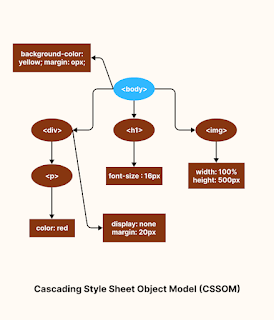Module 41 : Understand what CSS Houdini
Objective:
Understand what CSS Houdini is, why it matters, how it extends the capabilities of CSS, and how to use Custom Properties (variables) with Houdini for powerful, dynamic, and performant web styling.
2. What is CSS Houdini?
Definition:
CSS Houdini is a set of low-level APIs that allow developers to extend CSS by writing JavaScript that the browser can understand as if it were native CSS.
Why Houdini?
Traditionally, CSS is limited—you can't define new CSS features without waiting for browser vendors.
Houdini bridges the gap between CSS and JavaScript, giving devs the power to create custom styles, layouts, animations, and more.
It allows browsers to parse and render custom styles much faster than traditional JS + DOM manipulation.
3. CSS Houdini APIs Overview
Houdini includes several APIs:
API
Purpose
CSS Typed OM API
Works with CSS values as JS objects instead of strings
Paint Worklet API
Custom drawing with JavaScript (like canvas in CSS)
Layout Worklet API
Create custom layout algorithms
Animation Worklet API
Run animations off the main thread
Properties & Values API
Define and register custom CSS properties
This module focuses on Properties & Values API, essential for understanding Houdini and custom properties.
4. What are Custom Properties?
Custom Properties are variables defined in CSS using --name.
Example:
css
code
:root { --main-color: #3498db; } .box { background-color: var(--main-color); }
5. Registering Custom Properties with Houdini
Why Register?
Normally, CSS variables are treated as generic strings. Registering a property gives the browser more information:
Its type (e.g., <color>, <length>)
Default value
Whether it inherits
This improves performance and enables advanced features (like animations, typed values, etc.).
6. How to Register Custom Properties (Step-by-step)
Step 1: Enable Houdini in Browser
Make sure your browser supports Houdini (latest Chrome, Edge, etc.).
Step 2: Use CSS.registerProperty()
javascript
code
if ('registerProperty' in CSS) { CSS.registerProperty({ name: '--magic-color', syntax: '<color>', inherits: false, initialValue: '#ff00ff' }); }
Now you can use --magic-color in your CSS and it will be treated like a native <color> property.
7. Practical Example: Animating a Custom Color Property
HTML + CSS + JS
html
code
<div class="magic-box"></div> <style> .magic-box { width: 200px; height: 200px; background-color: var(--magic-color, #000); transition: --magic-color 1s ease-in-out; } .magic-box:hover { --magic-color: #00ff00; } </style> <script> if ('registerProperty' in CSS) { CSS.registerProperty({ name: '--magic-color', syntax: '<color>', inherits: false, initialValue: '#ff00ff' }); } </script>
Explanation:
We register --magic-color as a <color> type.
CSS can now animate this property like a native background-color.
On hover, the color transitions smoothly because the browser understands it's a <color>.
8. Custom Progress Bar with Animated Variable
Objective:
Create a progress bar that uses a custom property --progress (type <percentage>) and animates it.
HTML + CSS + JS:
html
code
<div class="progress-container"> <div class="progress-bar"></div> </div> <style> .progress-container { width: 100%; height: 20px; background: #eee; overflow: hidden; border-radius: 10px; } .progress-bar { height: 100%; background: linear-gradient(to right, #76c7c0, #4b9e9e); transform: scaleX(calc(var(--progress) / 100)); transform-origin: left; transition: --progress 1s ease; } </style> <script> if ('registerProperty' in CSS) { CSS.registerProperty({ name: '--progress', syntax: '<percentage>', inherits: false, initialValue: '0%' }); } const progressBar = document.querySelector('.progress-bar'); // Simulate progress let progress = 0; setInterval(() => { progress += 10; if (progress > 100) progress = 0; progressBar.style.setProperty('--progress', `${progress}%`); }, 1000); </script>
Explanation:
Registers a <percentage> custom property.
Uses it in transform: scaleX() to visually grow the bar.
Transitions are smooth due to typed registration.
9. Exercise
Register a custom property --angle with syntax <angle>.
Apply it to rotate an image on hover with animation.
Make it rotate from 0deg to 45deg.
Hint:
css
code
transform: rotate(var(--angle)); transition: --angle 0.5s;
10. Best Practices
Always check browser support with if ('registerProperty' in CSS) to avoid breaking old browsers.
Use fallback values with var(--prop, fallback).
Register custom properties before using them.
Use typed values to unlock animation capabilities.
11. Summary
Feature
Benefit
Custom Properties
Reusable and dynamic styling
Houdini registerProperty
Performance boost and animation support
Typed Syntax
CSS can handle properties natively
Smooth Animations
Registering properties enables browser-native transitions
12. Extension (Optional): Dynamic Themes
Goal:
Create a theme switcher using registered --theme-color property.
Try it:
Define two themes (light/dark)
Use JavaScript to switch --theme-color and see animation.
13. Use Cases
Animated gradients
Advanced theming
Dynamic charts with CSS-driven transitions
Visual effects (like waves, shapes) with Paint API + custom props
14. Final Thoughts
CSS Houdini is the future of dynamic styling. Mastering custom properties with Houdini will give you:
More control
Better performance
Creative freedom beyond standard CSS limitations







No comments:
Post a Comment